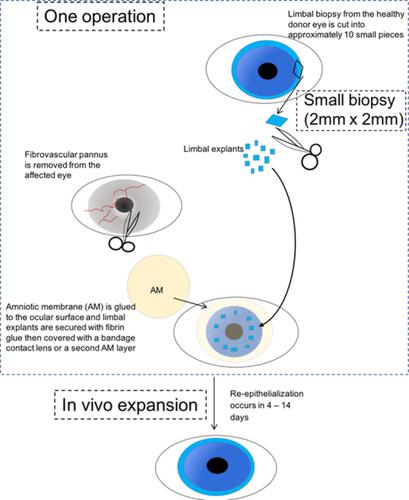当前位置:
X-MOL 学术
›
Stem Cells Transl. Med.
›
论文详情
Our official English website, www.x-mol.net, welcomes your feedback! (Note: you will need to create a separate account there.)
Simple limbal epithelial transplantation: Current status and future perspectives.
STEM CELLS Translational Medicine ( IF 6 ) Pub Date : 2019-12-04 , DOI: 10.1002/sctm.19-0203 Catherine J Jackson 1, 2, 3 , Inger T Myklebust Ernø 2 , Håkon Ringstad 4 , Kim A Tønseth 1, 4 , Darlene A Dartt 5 , Tor P Utheim 1, 2, 3, 6, 7, 8, 9, 10
STEM CELLS Translational Medicine ( IF 6 ) Pub Date : 2019-12-04 , DOI: 10.1002/sctm.19-0203 Catherine J Jackson 1, 2, 3 , Inger T Myklebust Ernø 2 , Håkon Ringstad 4 , Kim A Tønseth 1, 4 , Darlene A Dartt 5 , Tor P Utheim 1, 2, 3, 6, 7, 8, 9, 10
Affiliation

|
Damage to limbal stem cells as a result of injury or disease can lead to limbal stem cell deficiency (LSCD). This disease is characterized by decreased vision that is often painful and may progress to blindness. Clinical features include inflammation, neovascularization, and persistent cornea epithelial defects. Successful strategies for treatment involve transplantation of grafts harvested from the limbus of the alternate healthy eye, called conjunctival‐limbal autograft (CLAU) and transplantation of limbal cell sheets cultured from limbal biopsies, termed cultured limbal epithelial transplantation (CLET). In 2012, Sangwan and colleagues presented simple limbal epithelial transplantation (SLET), a novel transplantation technique that combines the benefits of CLAU and CLET and avoids the challenges associated with both. In SLET a small biopsy from the limbus of the healthy eye is divided and distributed over human amniotic membrane, which is placed on the affected cornea. Outgrowth occurs from each small explant and a complete corneal epithelium is typically formed within 2 weeks. Advantages of SLET include reduced risk of iatrogenic LSCD occurring in the healthy cornea at harvest; direct transfer circumventing the need for cell culture; and the opportunity to perform biopsy harvest and transplantation in one operation. Success so far using SLET is comparable with CLAU and CLET. Of note, 336 of 404 (83%) operations using SLET resulted in restoration of the corneal epithelium, whereas visual acuity improved in 258 of the 373 (69%) reported cases. This review summarizes the results of 31 studies published on SLET since 2012. Progress, advantages, challenges, and suggestions for future studies are presented.
中文翻译:

单纯角膜缘上皮移植:现状和未来展望。
损伤或疾病对角膜缘干细胞的损害可导致角膜缘干细胞缺乏症(LSCD)。该疾病的特征是视力下降,通常是痛苦的并且可能发展为失明。临床特征包括炎症,新血管形成和持续性角膜上皮缺损。成功的治疗策略包括移植从另一只健康眼的角膜缘收集的移植物,称为结膜-自体角膜缘移植物(CLAU),以及从角膜缘活检组织培养的角膜缘细胞片的移植,称为培养角膜缘上皮移植(CLET)。在2012年,Sangwan及其同事提出了简单的角膜缘上皮移植(SLET),这是一种新颖的移植技术,结合了CLAU和CLET的优势,并避免了两者相关的挑战。在SLET中,将健康眼睛角膜缘的一小部分活检分开并分布在人类羊膜上,该羊膜放置在受影响的角膜上。每个小外植体都会发生生长,通常在2周内形成完整的角膜上皮。SLET的优势包括:健康的角膜收获时降低医源性LSCD发生的风险;直接转移避免了细胞培养的需要;并有机会一次完成活检的收获和移植。到目前为止,使用SLET取得的成功与CLAU和CLET相当。值得注意的是,使用SLET进行的404例手术中有336例(占83%)导致角膜上皮恢复,而报告的373例中有258例(69%)的视力得到了改善。这篇综述总结了自2012年以来SLET上发表的31项研究的结果。进展,优势,挑战,
更新日期:2019-12-04
中文翻译:

单纯角膜缘上皮移植:现状和未来展望。
损伤或疾病对角膜缘干细胞的损害可导致角膜缘干细胞缺乏症(LSCD)。该疾病的特征是视力下降,通常是痛苦的并且可能发展为失明。临床特征包括炎症,新血管形成和持续性角膜上皮缺损。成功的治疗策略包括移植从另一只健康眼的角膜缘收集的移植物,称为结膜-自体角膜缘移植物(CLAU),以及从角膜缘活检组织培养的角膜缘细胞片的移植,称为培养角膜缘上皮移植(CLET)。在2012年,Sangwan及其同事提出了简单的角膜缘上皮移植(SLET),这是一种新颖的移植技术,结合了CLAU和CLET的优势,并避免了两者相关的挑战。在SLET中,将健康眼睛角膜缘的一小部分活检分开并分布在人类羊膜上,该羊膜放置在受影响的角膜上。每个小外植体都会发生生长,通常在2周内形成完整的角膜上皮。SLET的优势包括:健康的角膜收获时降低医源性LSCD发生的风险;直接转移避免了细胞培养的需要;并有机会一次完成活检的收获和移植。到目前为止,使用SLET取得的成功与CLAU和CLET相当。值得注意的是,使用SLET进行的404例手术中有336例(占83%)导致角膜上皮恢复,而报告的373例中有258例(69%)的视力得到了改善。这篇综述总结了自2012年以来SLET上发表的31项研究的结果。进展,优势,挑战,



























 京公网安备 11010802027423号
京公网安备 11010802027423号